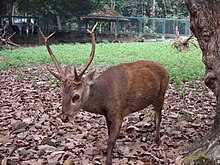Bawean deer
| Bawean deer | |
|---|---|
 |
|
| Scientific classification | |
| Kingdom: | Animalia |
| Phylum: | Chordata |
| Clade: | Synapsida |
| Class: | Mammalia |
| Order: | Artiodactyla |
| Family: | Cervidae |
| Subfamily: | Cervinae |
| Genus: | Hyelaphus |
| Species: | H. kuhlii |
| Binomial name | |
|
Hyelaphus kuhlii Müller, 1840 |
|
 |
|
| Orange arrow points to Bawean Island. Green on inserted map highlights approximate range of Bawean deer on the island. |
|
| Synonyms | |
|
Axis kuhlii |
|
Axis kuhlii
The Bawean deer (Hyelaphus kuhlii), also known as Kuhl's hog deer or Bawean hog deer, is a highly threatened species of deer found only in the island of Bawean (Gresik Regency) in Indonesia.
A typical height for males of 60–70 cm has been reported. Males have three-tined antlers.
Their fawns are spotted at birth, which separates them from the best known western population of the hog deer (H. porcinus).
Due to ongoing habitat loss, small population size and limited range, the Bawean deer is evaluated as critically endangered on the IUCN Red List of Threatened Species. It is listed on Appendix I of CITES. It has few natural enemies except for birds of prey and large snakes such as pythons.
Bawean deer reside on the Bawean island in Indonesia, close to the Java Sea. The Bawean deer is sometimes included with the Indian hog deer Hyelaphus porcinus (Haltenorth 1963), but it is a total different species (Groves and Grubb 1987; Grubb 2005). The most recent analyses indicate that these two species, together with calamianensis, constitute a different genus distinct from Axis, and Hyelaphus (Meijaard and Groves 2004, Pitra et al. 2004).
They live in woodlands and upland forests with dense undergrowth which is used for shelter, providing a refuge in which the deer sleep and rest during the day. They live in small groups of four or five deer mostly one female, the infant, and two males. They are herbivores and consume grasses, herbs, leaves, twigs, corn crops, and leaves of the cassave plants. Their pelage is short, smooth, and soft, and generally a light brown in color. There are few distinctive yellow markings which are limited to the head and neck, there is also a light throat patch or 'bib' and a whitish eye-ring, infants have white spots on their backs when younger. Females will have one offspring at a time per year. The gestation period is 225–230 days, and the majority of births occur in February to June.
...
Wikipedia

